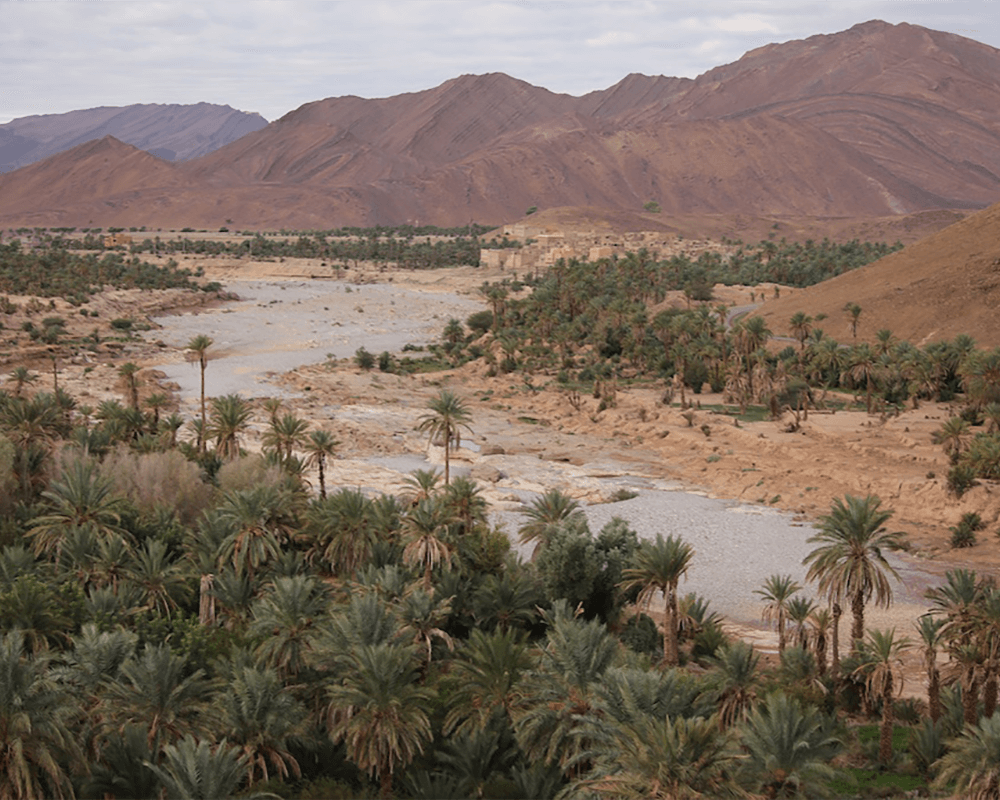Wer in Marokko Sahara erleben will, reist in den Südosten des Landes. Dort verzaubert die marokkanische Sahara Wüste mit ihrer beeindruckenden Weite, ihren kulturellen Schätzen und atemberaubenden Landschaften. Eine Reise dorthin führt durch abwechslungsreiche Regionen und bietet einzigartige Einblicke in das Leben der Menschen, die seit Jahrhunderten mit der Wüste Sahara verbunden sind. Für jene, die tiefer in fremde Kulturen eintauchen möchten, eröffnen sich unzählige Möglichkeiten, neue Perspektiven zu entdecken und die Vielfalt Marokkos zu erleben.
Die Reise beginnt mit der Überquerung des Hohen Atlas. Auf dem Weg über den Tizi n'Tichka-Pass eröffnen sich faszinierende Ausblicke, gekrönt von Regenbögen über den Tälern - ein Vorgeschmack auf den Zauber des Südens.
 Das Draa-Tal – Oase der Geschichten
Das Draa-Tal – Oase der Geschichten
Das Draa-Tal, berühmt für sein weitläufiges Palmenmeer und die traditionellen Lehmbauten der Kasbahs, ist eine wahre Perle des Südens. In Tamnougalt, einer alten Ksar-Siedlung, lassen sich architektonische Einflüsse jüdischer, maurischer und marokkanischer Traditionen entdecken. Ein Rundgang durch die engen Gassen, begleitet von Erzählungen über das Dorfleben, offenbart die Geschichte einer Region mitten in der Sahara Marokkos, die einst stark landwirtschaftlich geprägt war.
Inmitten der Gärten des Tals laden hoch aufragende Palmen zum Verweilen ein, während frische Datteln direkt vom Baum probiert werden können – eine einfache, aber unvergessliche Freude.

 Erg Chigaga – Magie der Wüste Marokkos
Erg Chigaga – Magie der Wüste Marokkos
Weiter geht es zum Erg Chigaga, wo Dünen in den Himmel ragen und das Leben der Nomaden sichtbar wird. Nach einem seltenen Regen erwacht die Gegend zu neuem Leben. Ein Kamelritt bei Sonnenuntergang taucht die Sahara Marokkos in ein warmes Licht aus Rosa- und Orangetönen - ein unvergesslicher Moment, bevor die Nacht in einem traditionellen Zeltlager beginnt.
Nach einem spektakulären Sonnenaufgang geht es weiter nach Foum Zguid und Tata. Dort wartet ein historisches Gästehaus mit Blick auf ein weitläufiges Palmenmeer. Ein idealer Ort, um die Ruhe des Südens zu genießen.
 Tata – Tradition und Gemeinschaft
Tata – Tradition und Gemeinschaft
Das Palmenmeer von Tata ist nicht nur landschaftlich beeindruckend, sondern auch ein Ort, an dem jahrhundertealte Bewässerungstechniken noch immer Anwendung finden. Der Besuch des zentralen Wasserturms gibt Einblick in die Verteilung des kostbaren Gutes - eine Kunst, die die Gemeinschaft seit Generationen prägt.
Zwischen den Palmen begegnen Reisende den Einheimischen bei ihrer täglichen Arbeit, sei es beim Transport von Waren oder bei der Ernte der Datteln. Diese werden hier vor allem für den Eigenbedarf geerntet und gelten als Ausdruck der Verbundenheit mit der Natur.
 Der Anti-Atlas – Geschichte und Ausblicke über die Marokko Sahara
Der Anti-Atlas – Geschichte und Ausblicke über die Marokko Sahara
Von Tata aus führt der Weg in die Ausläufer des Anti-Atlas. Hier liegen auf steilen Hügeln jahrhundertealte Kornspeicher, die Agadire. Sie erzählen von einer Zeit, in der die Familien ihre Ernte vor Angreifern schützten und in kleinen Kammern Datteln, Oliven und Honig lagerten. Der Aufstieg zu einer dieser Anlagen belohnt mit weiten Blicken über das Tal, einem Ort, an dem Geschichte spürbar wird.

© All photos via Mandy Sinclair
Der Zauber des Südens
Die Sahara Wüste in Marokko und der Süden des Landes verzaubern mit einer Mischung aus unberührter Natur, lebendigen Traditionen und herzlicher Gastfreundschaft. Eine Reise dorthin hinterlässt bleibende Eindrücke - von den Palmenhainen des Draa-Tals über die goldenen Dünen des Erg Chigaga bis zu den felsigen Höhen des Anti-Atlas.
Die ungreifbare Faszination Marokkos hinterlässt eine tief verwurzelte Sehnsucht, das Erlebte erneut zu erfahren. Dieses Land inspiriert durch seine kulturelle Vielfalt, seine Landschaften und die herzliche Gastfreundschaft. Wer den Süden Marokkos besucht, taucht ein in eine Welt voller Geschichten, Traditionen und atemberaubender Landschaften - ein Abenteuer, das lange nachwirkt sich perfekt mit einer gut geplanten Marokko-Sahara-Tour erleben lässt. Ergänzend dazu bieten sich zahlreiche andere Reisetipps, um die vielfältigen Facetten Marokkos zu entdecken.



 Das Draa-Tal – Oase der Geschichten
Das Draa-Tal – Oase der Geschichten Erg Chigaga – Magie der Wüste Marokkos
Erg Chigaga – Magie der Wüste Marokkos Tata – Tradition und Gemeinschaft
Tata – Tradition und Gemeinschaft Der Anti-Atlas – Geschichte und Ausblicke über die Marokko Sahara
Der Anti-Atlas – Geschichte und Ausblicke über die Marokko Sahara


Share: